2003 GMC SIERRA DENALI wiper fluid
[x] Cancel search: wiper fluidPage 132 of 428
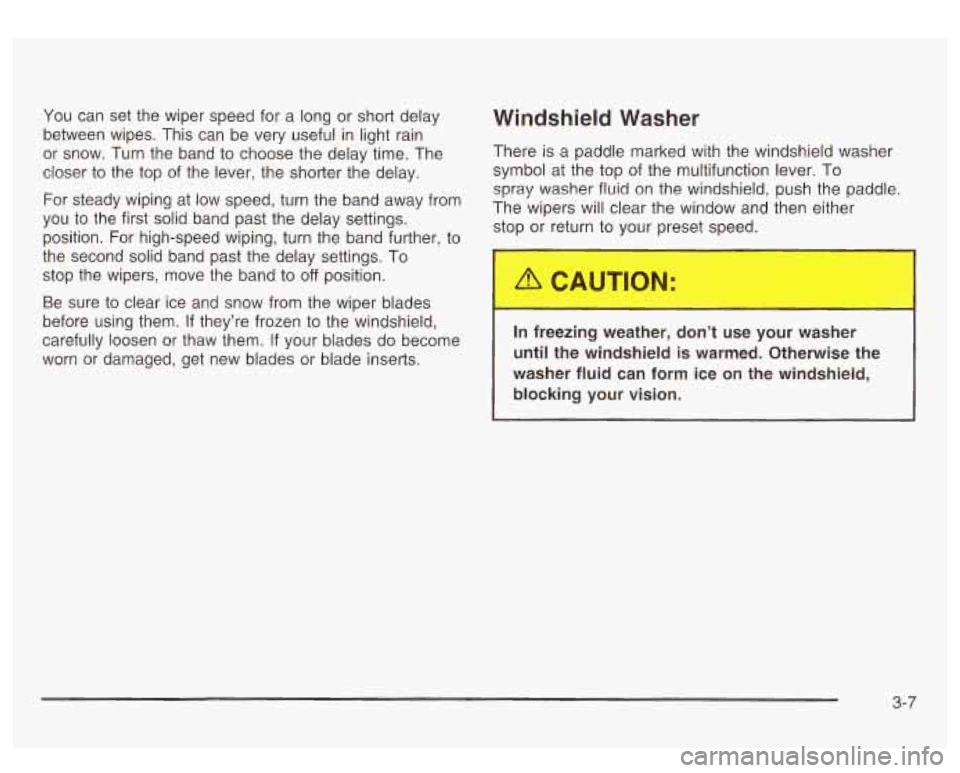
You can set the wiper speed for a long or short delay
between wipes. This can be very useful in light rain
or snow. Turn the band to choose the delay time. The
closer
to the top of the lever, the shorter the delay.
For steady wiping at low speed, turn the band away from
you to the first solid band past the delay settings.
position. For high-speed wiping, turn the band further, to
the second solid band past the delay settings.
To
stop the wipers, move the band to off position.
Be sure to clear ice and snow from the wiper blades
before using them.
If they’re frozen to the windshield,
carefully loosen or thaw them. If your blades do become
worn or damaged, get new blades or blade inserts.
Windshield Washer
There is a paddle marked with the windshield washer
symbol at the top of the multifunction lever. To
spray washer fluid on the windshield, push the paddle.
The wipers will clear the window and then either
stc~- 3r return to your preset -reed.
In freezing weather, don’t use your washer
until the windshield is warmed. Otherwise the
washer fluid can form ice on the windshield,
blocking your vision.
3-7
Page 240 of 428
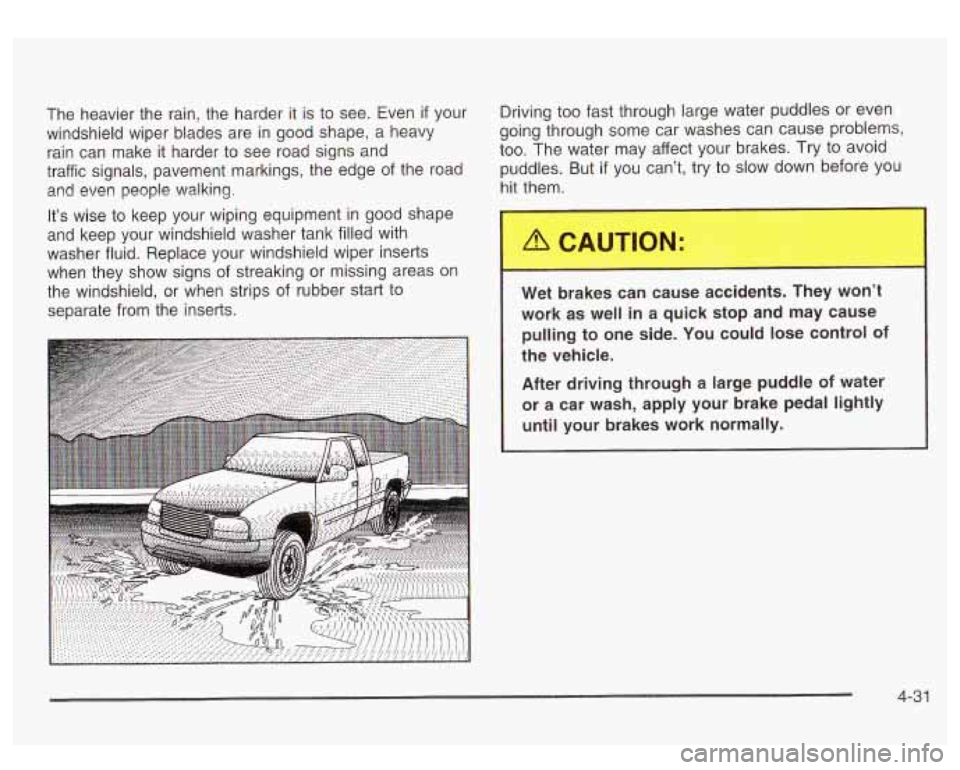
The heavier the rain, the harder it is to see. Even if your
windshield wiper blades are in good shape, a heavy
rain can make it harder to see road signs and
traffic signals, pavement markings, the edge of the road
and even people walking.
It's wise to keep your wiping equipment in good shape
and keep your windshield washer tank filled with
washer fluid. Replace your windshield wiper inserts
when they show signs of streaking or missing areas on
the windshield, or when strips of rubber start to
separate from the inserts. Driving too fast through large
water puddles or even
going through some car washes can cause problems,
too. The water may affect your brakes. Try to avoid
puddles. But
if you can't, try to slow down before you
hit them.
Wet brakes
4 1 cause accidents. They won't
work as well in a quick stop and may cause
pulling
to one side. You could lose control of
the vehicle.
After driving through a large puddle of water
or a car wash, apply your brake pedal lightly
until your brakes work normally.
4-3 1
Page 244 of 428
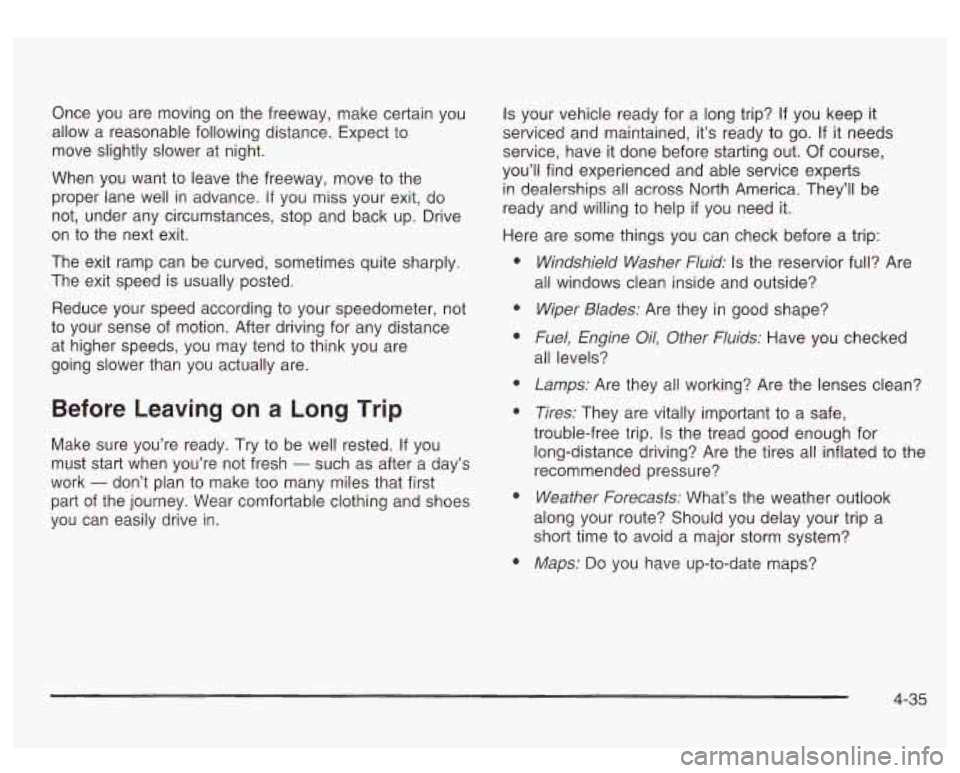
Once you are moving on the freeway, make certain you
allow a reasonable following distance. Expect to
move slightly slower at night.
When you want
to leave the freeway, move to the
proper lane well in advance.
If you miss your exit, do
not, under any circumstances, stop and back up. Drive
on to the next exit.
The exit ramp can be curved, sometimes quite sharply.
The exit speed is usually posted.
Reduce your speed according to your speedometer, not
to your sense of motion. After driving for any distance
at higher speeds, you may tend
to think you are
going slower than you actually are.
Before Leaving on a Long Trip
Make sure you’re ready. Try to be well rested. If you
must start when you’re not fresh
- such as after a day’s
work
- don’t plan to make too many miles that first
part of the journey. Wear comfortable clothing and shoes
you can easily drive in.
Is your vehicle ready for a long trip? If you keep it
serviced and maintained, it’s ready to go. If it needs
service, have it done before starting out.
Of course,
you’ll find experienced and able service experts
in dealerships all across North America. They’ll be
ready and willing to help
if you need it.
Here are some things you can check before a trip:
e
e e
e
e
e
e
Windshield Washer Fluid: Is the reservior full? Are
all windows clean inside and outside?
Wiper Blades: Are they in good shape?
Fuel, Engine Oil, Other Fluids: Have you checked
all levels?
Lamps: Are they all working? Are the lenses clean?
Tires: They are vitally important to a safe,
trouble-free trip.
Is the tread good enough for
long-distance driving? Are the tires all inflated to the
recommended pressure?
Weather Forecasts: What’s the weather outlook
along your route? Should you delay your trip a
short time to avoid a major storm system?
Maps: Do you have up-to-date maps?
4-35
Page 270 of 428
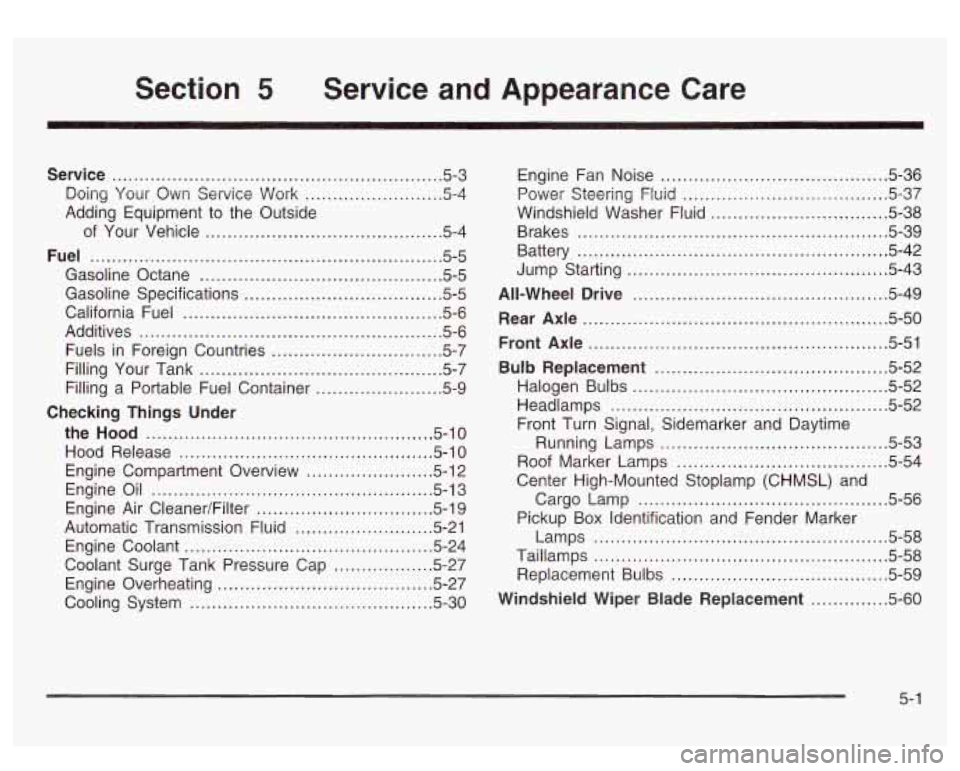
Section 5 Service and Appearance Care
Service ............................................................ 5.3
Doing Your Own Service Work
......................... 5-4
Adding Equipment to the Outside
of Your Vehicle
........................................... 5-4
Fuel
................................................................ 5.5
Gasoline Octane
............................................ 5.5
Gasoline Specifications
.................................... 5.5
California Fuel
............................................... 5.6
Additives
....................................................... 5.6
Fuels in Foreign Countries
................. ....... 5.7
Filling Your Tank
......................................... 5-7
Filling a Portable Fuel Container
.................... 5-9
the Hood
............................................. 5.10
Hood Release
........................................ ,.5-10
Engine Compartment Overview
....................... 5.12
Checking
Things Under
Engine Oil
................................................... 5.13
Engine Air Cleaner/Filter
................................ 5.19
Engine Coolant
............................................. 5.24
Engine Overheating
....................................... 5.27
Cooling System
............................................ 5.30
Automatic
Transmission Fluid
........................ -5-21
Coolant Surge Tank Pressure Cap
.................. 5-27 Engine
Fan Noise
......................................... 5.36
Power Steering Fluid
..................................... 5.37
Windshield Washer Fluid
................................ 5-38
Brakes
........................................................ 5.39
Battery
........................................................ 5.42
Jump Starting
............................................... 5.43
All-Wheel Drive
......................... .............. 5-49
Rear Axle
....................................................... 5-50
Front Axle
...................................................... 5-51
Bulb Replacement
.......................................... 5-52
Halogen Bulbs
.............................................. 5-52
Headlamps
................................................. -5-52
Roof Marker Lamps
...................................... 5-54
Cargo Lamp
............................................. 5-56
Taillamps
..................................................... 5-58
Replacement Bulbs
....................................... 5-59
Front
Turn Signal, Sidemarker
and Daytime
Running Lamps
......................................... 5-53
Center High-Mounted Stoplamp (CHMSL) and
Pickup
Box Identification and Fender Marker
Lamps
..................................................... 5-58
Windshield Wiper Blade Replacement
.............. 5-60
5-
1
Page 386 of 428
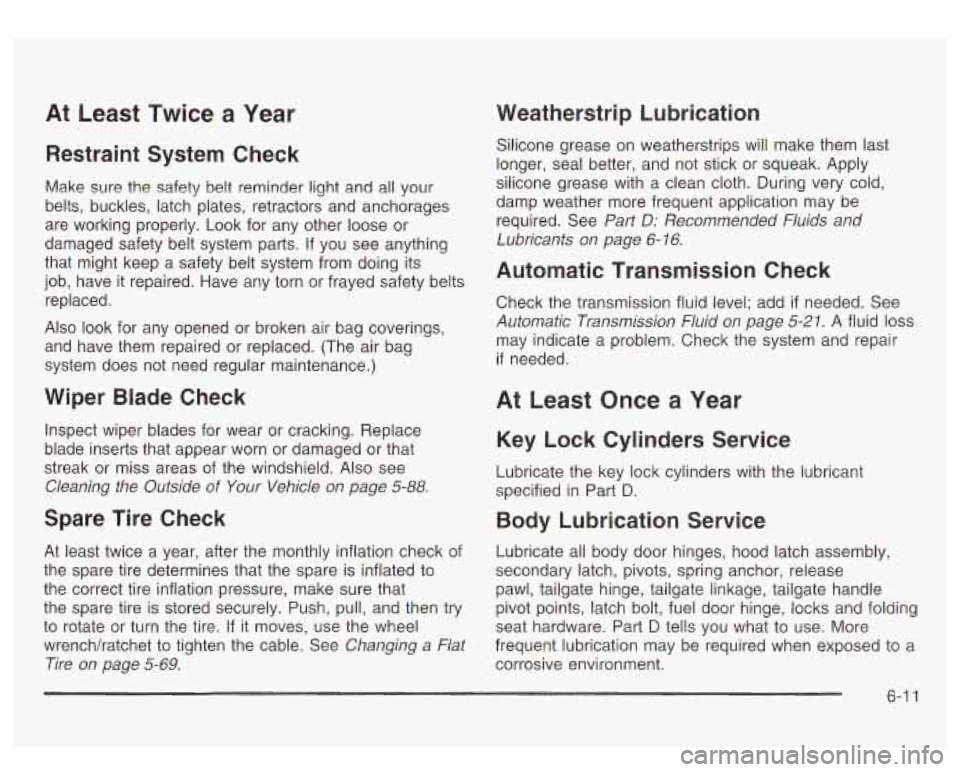
At Least Twice a Year
Restraint System Check
Make sure the safety belt reminder light and all your
belts, buckles, latch plates, retractors and anchorages
are working properly. Look for any other loose or
damaged safety belt system parts.
If you see anything
that might keep a safety belt system from doing its
job, have it repaired. Have any torn or frayed safety belts
replaced.
Also look for any opened or broken air bag coverings,
and have them repaired or replaced. (The air bag
system does not need regular maintenance.)
Wiper Blade Check
Inspect wiper blades for wear or cracking. Replace
blade inserts that appear worn or damaged or that
streak or miss areas of the windshield.
Also see
Cleaning the Outside of Your Vehicle on page 5-88.
Spare Tire Check
At least twice a year, after the monthly inflation check of
the spare tire determines that the spare is inflated to
the correct tire inflation pressure, make sure that
the spare tire is stored securely. Push, pull, and then try
to rotate or turn the tire. If it moves, use the wheel
wrenchhatchet to tighten the cable. See
Changing a Flat
Tire on page 5-69.
Weatherstrip
Silicone grease on
longer, seal better,
Lubrication
weatherstrips will make them last
and not stick or squeak. Apply
silicone grease with a clean cloth. During very -cold,
damp weather more frequent application may be
required. See
Part D: Recommended Fluids and
lubricants on page
6- 16.
Automatic Transmission Check
Check the transmission fluid level; add if needed. See
Automatic Transmission Fluid on page 5-27. A fluid loss
may indicate a problem. Check the system and repair
if needed.
At Least Once a Year
Key Lock Cylinders Service
Lubricate the key lock cylinders with the lubricant
specified in Part D.
Body Lubrication Service
Lubricate all body door hinges, hood latch assembly,
secondary latch, pivots, spring anchor, release
pawl, tailgate hinge, tailgate linkage, tailgate handle
pivot points, latch bolt, fuel door hinge, locks and folding
seat hardware. Part
D tells you what to use. More
frequent lubrication may be required when exposed to a
corrosive environment.
6-1 1
Page 415 of 428

Fluid Automatic Transmission
................................ 5-21
Power Steering
........................................... 5-37
Windshield Washer
...................................... 5-38
FM Stereo
..................................................... 3-82
Fog Lamps
.................................................... 3-14
Folding the Rear Seat
....................................... 1-7
Following Distance
.......................................... 4-57
Footnotes
........................................................ 6-5
Front Axle
...................................................... 5-51
Front Reading Lamps
...................................... 3-15
Fuel
............................................................... 5-5
Additives ...................................................... 5-6
California Fuel
.............................................. 5-6
Filling a Portable Fuel Container
..................... 5-9
Filling Your Tank
........................................... 5-7
Fuels in Foreign Countries .............................. 5-7
Gage ......................................................... 3-42
Gasoline Octane
........................................... 5-5
Gasoline Specifications .................................. 5-5
Low Warning Light ....................................... 3-42
System Inspection
....................................... 6-14
Fuel Information Button
.................................... 3-46
FUEL LEVEL LOW
......................................... 3-58
Fuses Fuses and Circuit Breakers
........................... 5-95
Windshield Wiper ......................................... 5-95
G
Gage
Engine Coolant Temperature
......................... 3-36
Fuel
.......................................................... 3-42
Oil Pressure
........................................... 3-40
Speedometer
.......................................... 3-26
Tachometer
................................................. 3-26
Transmission Temperature
............................. 3-36
Voltmeter Gage
........................................... 3-33
Garage Door Opener
....................................... 2-35
Gasoline
Octane
.................................................... 5-5
Specifications
............................................... 5-5
Glass Surfaces ............................................... 5-88
Glove Box
..................................................... 2-39
GM Mobility Program for Persons with
Disabilities
.................................................... 7-5
Gate
Operator and Canadian Programming
........ 2-37
Hazard Warning Flashers
............................... 3-3
Head Restraints
............................................... 1-6
Headlamp High/Low Beam Changer
.................... 3-6
Headlamps
.................................................... 5-52
Bulb Replacement
....................................... 5-52
Front Turn Signal, Sidemarker and Daytime
Running Lamps
........................................ 5-53
Page 425 of 428
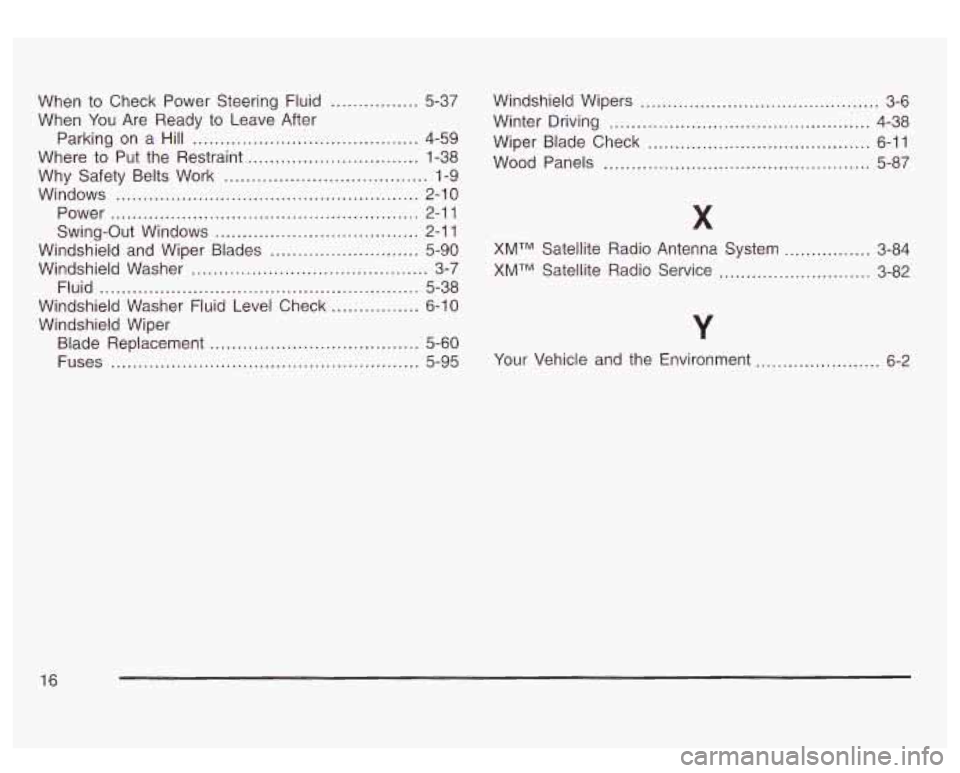
When to Check Power Steering Fluid ................ 5-37
Parking on a Hill
......................................... 4-59
When
You Are Ready to Leave After
Where to Put the Restraint
............................... 1-38
Why Safety Belts Work
..................................... 1-9
Windows
....................................................... 2-10
Power
........................................................ 2-11
Swing-Out Windows
..................................... 2-11
Windshield and Wiper Blades
........................... 5-90
Windshield Washer
........................................... 3-7
Fluid
.......................................................... 5-38
Windshield Washer Fluid Level Check
................ 6-10
Windshield Wiper
Blade Replacement
...................................... 5-60
Fuses
........................................................ 5-95 Windshield
Wipers
............................................ 3-6
Winter Driving
................................................ 4-38
Wiper Blade Check
......................................... 6-11
Wood Panels
................................................. 5-87
X
XMTM Satellite Radio Antenna System ................ 3-84
XMTM Satellite Radio Service
............................ 3-82
Your Vehicle and the Environment
........., .......... 6-2
16